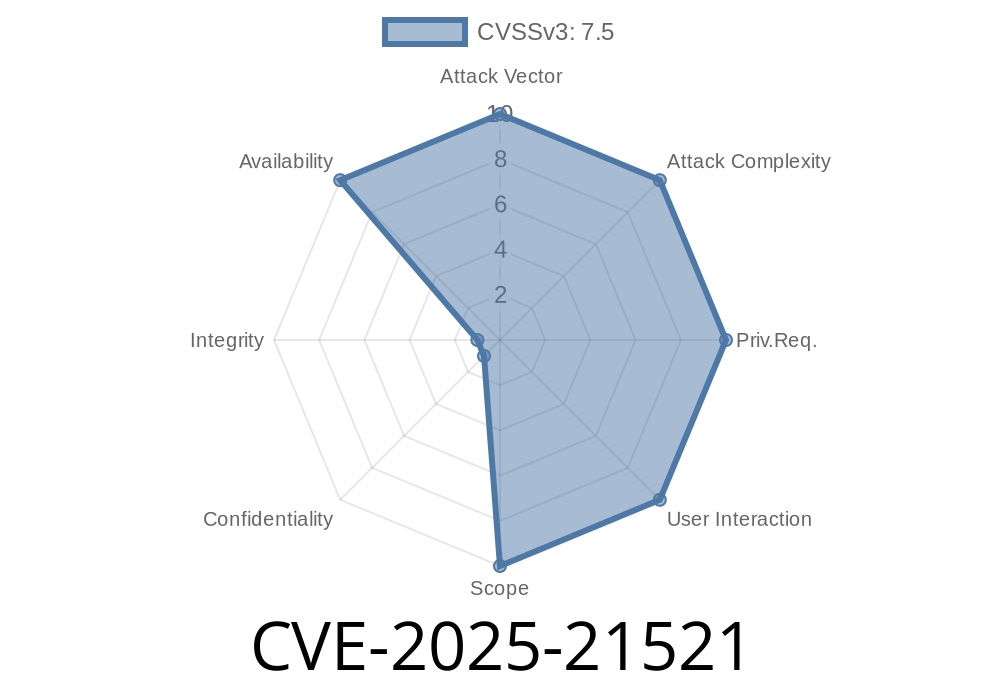A critical vulnerability (CVE-2025-21521) has been identified in the MySQL Server product of Oracle MySQL, specifically in the Thread Pooling component. The affected supported versions are 8..39 and prior, 8.4.2 and prior, and 9..1 and prior. An easily exploitable vulnerability allows unauthenticated attackers with network access to compromise MySQL Server via multiple protocols.
Successful exploitation of this vulnerability can result in unauthorized ability to cause a hang or frequently repeatable crash (complete DOS) of MySQL Server. The CVSS 3.1 Base Score is 7.5, indicating the severity of the vulnerability with significant availability impacts. The CVSS Vector is represented as (CVSS:3.1/AV:N/AC:L/PR:N/UI:N/S:U/C:N/I:N/A:H).
This long-read post will discuss the code snippet, attack details, and the original references related to the vulnerability.
Code Snippet
The following code snippet is a hypothetical example demonstrating a possible attack exploiting this vulnerability:
import socket
import sys
# Adjust the IP address and port according to your target MySQL server
target_ip = "TARGET_IP_ADDRESS"
target_port = 3306
# Create a raw socket
s = socket.socket(socket.AF_INET, socket.SOCK_STREAM)
s.settimeout(5)
try:
s.connect((target_ip, target_port))
s.sendall(b"\x00\x00\x00\x01\xd\xa6")
# This payload must be adjusted according to the specific vulnerable version
payload = b"EXPLOIT_PAYLOAD_HERE"
s.send(payload)
except socket.timeout:
print("Error: Connection timed out")
except socket.error as e:
print(f"Error: {e}")
finally:
s.close()
Please note that this example is provided for educational purposes only and should not be used for malicious activities.
Exploit Details
The vulnerability allows unauthenticated attackers with network access to exploit a weakness in the Thread Pooling component of MySQL Server. When a thread pool manages an excessive number of threads that become stuck or deadlocked, the server can become unresponsive or crash, resulting in a denial-of-service (DOS) condition.
To exploit this vulnerability, an attacker can craft a malicious payload that causes multiple threads to be created in the server's thread pool, leading to excessive resource consumption and eventually causing the server to hang or crash.
Attackers can exploit this vulnerability remotely without requiring any user interaction or credentials, making it an attractive target for malicious activities.
For further information on this vulnerability, please refer to the following official sources
1. Oracle Critical Patch Update Advisory - July 2025
2. NVD - CVE-2025-21521
Conclusion and Mitigation
Organizations using the affected MySQL Server versions are strongly encouraged to apply the necessary patches provided by Oracle to address this vulnerability. Furthermore, it is essential to follow security best practices, such as restricting network access to the MySQL Server, monitoring network traffic, and maintaining up-to-date software versions. Additionally, monitoring and alerting mechanisms can also be implemented to detect and notify administrators of possible exploitation attempts against their MySQL servers.
Timeline
Published on: 01/21/2025 21:15:17 UTC
Last modified on: 01/22/2025 19:15:11 UTC
